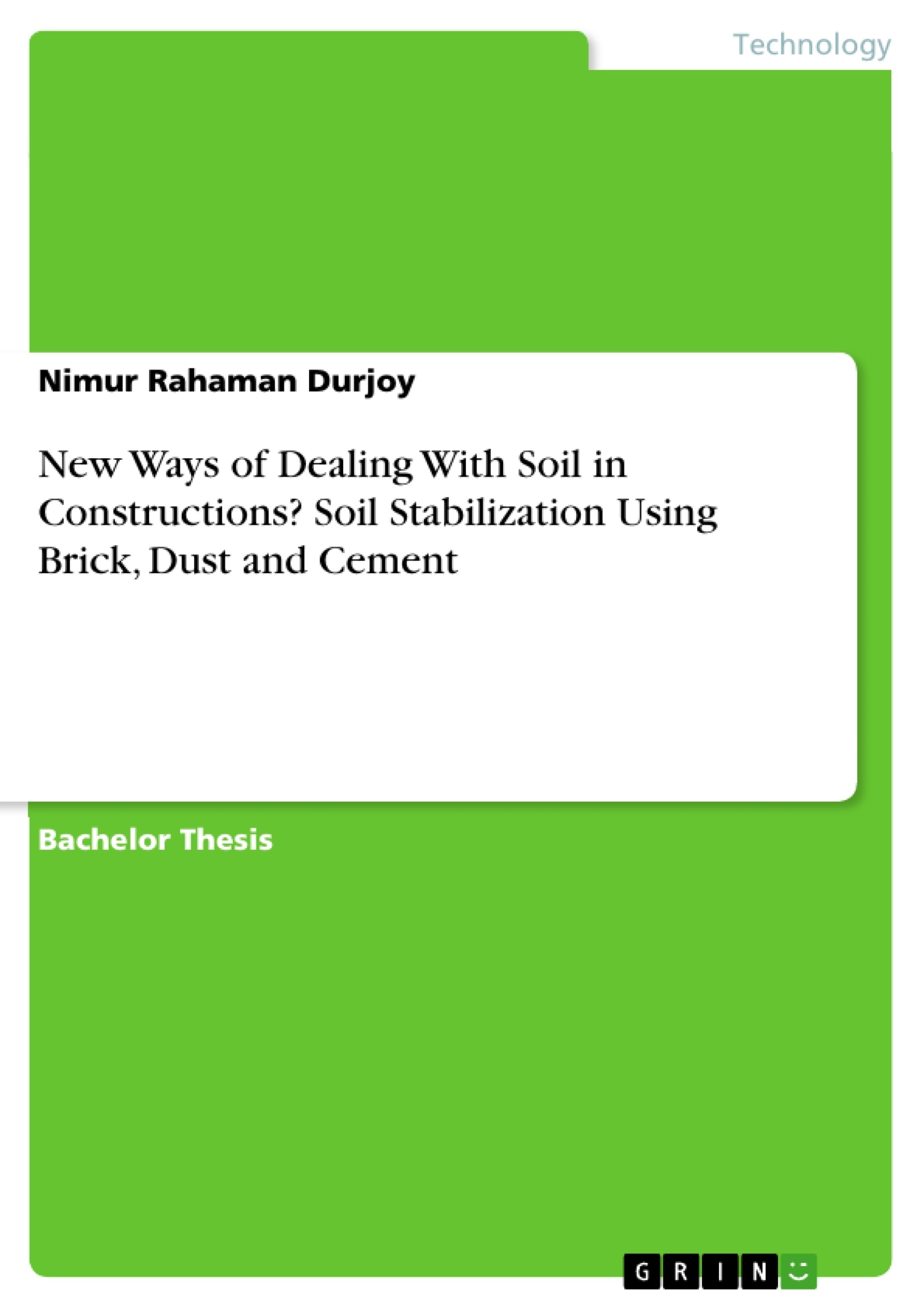The nature of soil is an ambiguous property unlike it is treated to know the basic engineering parameters. Usually, soil and soft soils cause difficulties in construction site when having low strength and low stiffness. To enhance the engineering property, soil needs to be stabilized. This study is an experimental base research where brick dust and cement are used to stabilize the soil to explore the more uses of raw materials like this as well as to improve the quality of soft soil at the proposed site of Manikdi, Dhaka.
The soil is classified as a clayey soil and determined the plastic limit, liquid limit, specific gravity, grain size. Secondly, to compare the strength and characteristics of existing soil before and after treating with the combination of brick dust and cement. We used two different mixed ratio and natural soil to conduct this experiment. From unconfined compression strength test of natural soil, soil with mix ratio (Cement: Brick Dust: Soil=1:1.5:7) and soil with mixed ratio (Cement: Brick Dust: Soil=1:2:7) were 483.7 kPa, 737.2 kPa and 967.8 kPa consequently. So, we found that the stress is increasing with increasing amount of cement and brick dust. From The grain size analysis, the Cu value of natural soil, soil with mix ratio (Cement: Brick Dust: Soil=1:1.5:7) and soil with mixed ratio (Cement: Brick Dust: Soil=1:2:7) were 4.3, 5.06 and 3.25 consequently. Also we found that the Cc value of natural soil, soil with mix ratio (Cement: Brick Dust: Soil=1:1.5:7) and soil with mixed ratio (Cement: Brick Dust: Soil=1:2:7) were 0.84, 0.879 and 0.83 consequently. So for this three cases the soil sample was poorly graded. From the Atterberg limit test the liquid limit for natural soil, soil with mix ratio (Cement: Brick Dust: Soil=1:1.5:7) and soil with mixed ratio (Cement: Brick Dust: Soil=1:2:7) were 36.07%, 34.63% and 33.17% consequently, the plastic limit were 24.81%, 22.09% and 21.08% consequently. So, we can say that the liquid limit and plastic limit is decreasing with increasing amount of cement and brick dust.
Inhaltsverzeichnis (Table of Contents)
- CHAPTER I
- INTRODUCTION
- 1.1 Overview
- 1.2 Advantage of soil stabilization
- 1.3 Purpose of the Work
- 1.4 Objectives of the study
- 1.5 Scope of the study
- 1.6 Thesis layout
- CHAPTER II
- LITERATURE REVIEW
- 2.1 General
- 2.2 Related Work
- 2.3 Atterberg Limits
- 2.4 Specific gravity of soil
- 2.3 Unconfined compression Strength
- CHAPTER III
- METHODOLOGY
- 3.1 Geology of the Site
- 3.1.1 Soft Soil
- 3.1.2 Brick Dust and Cement
- 3.2 Sample Preparation
- 3.3 Laboratory test conducted in the laboraty
- 3.4 Grain size analysis
- 3.5 Determination of Specific Gravity of Soil
- 3.6 Unconfined Compression test of Soil Sample
Zielsetzung und Themenschwerpunkte (Objectives and Key Themes)
This thesis investigates the effectiveness of using a combination of brick dust and cement to stabilize soft soil. The study aims to explore the potential of these readily available materials to enhance the engineering properties of soil, particularly for construction projects. It focuses on the improvement of soil strength and stiffness, ultimately contributing to the construction of safer and more durable structures.
- Soil Stabilization Techniques
- Engineering Properties of Soil
- Brick Dust and Cement as Soil Stabilizers
- Laboratory Testing and Analysis
- Practical Applications in Construction
Zusammenfassung der Kapitel (Chapter Summaries)
Chapter I provides an introduction to the subject of soil stabilization, highlighting the challenges associated with soft soil and the benefits of using stabilization techniques. It outlines the purpose, objectives, scope, and layout of the thesis.
Chapter II delves into the existing literature surrounding soil stabilization. It presents a general overview of soil stabilization methods and discusses related research efforts, specifically focusing on the Atterberg limits, specific gravity, and unconfined compression strength of soil.
Chapter III outlines the methodology employed in the research. It details the geology of the site, including the characteristics of soft soil, and describes the use of brick dust and cement as stabilizing agents. The chapter also outlines the sample preparation procedures and the laboratory tests conducted to analyze the soil's properties, including grain size analysis, determination of specific gravity, and unconfined compression testing.
Schlüsselwörter (Keywords)
The primary keywords and focus topics of this thesis include soil stabilization, soft soil, brick dust, cement, engineering properties, laboratory testing, unconfined compression strength, Atterberg limits, and specific gravity. The research explores the potential of utilizing readily available materials like brick dust and cement to enhance the engineering characteristics of soft soil, leading to safer and more reliable construction practices.
- Quote paper
- Nimur Rahaman Durjoy (Author), 2019, New Ways of Dealing With Soil in Constructions? Soil Stabilization Using Brick, Dust and Cement, Munich, GRIN Verlag, https://www.grin.com/document/922181



